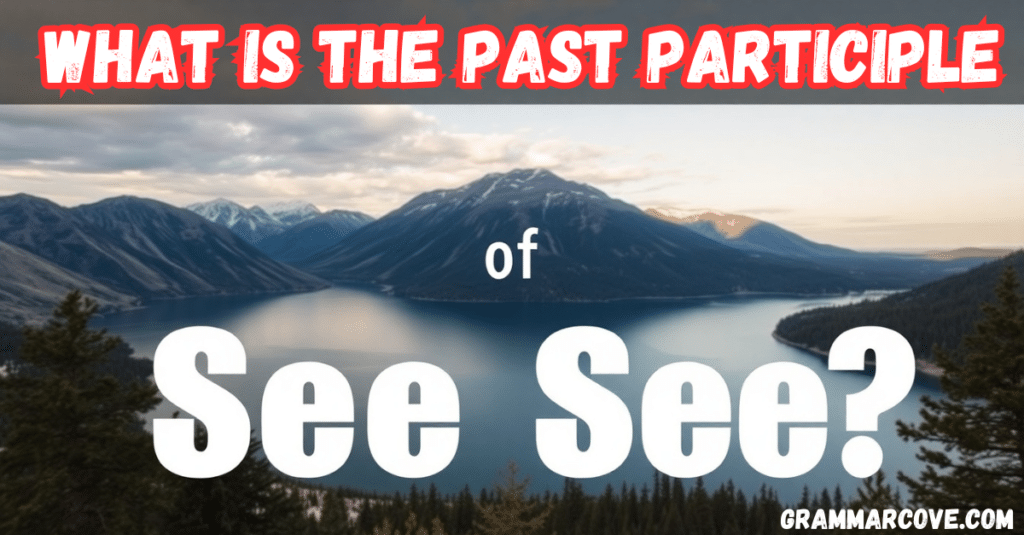The past tense of see and its past participle can be tricky for many English learners. You’ve probably encountered the two forms — “saw” and “seen” — but you might not always know when to use each one. While they both stem from the verb “see”, their usage depends on the sentence structure, which can be confusing if you’re not familiar with how past tense grammar rules apply to irregular verbs.
In this article, we’ll explore the past tense of see, the past participle of see, the differences between “saw” and “seen”, and much more. Plus, we’ll provide helpful examples, some common mistakes to avoid, and practical advice for using “saw” and “seen” correctly.
By the end of this article, you’ll have a clear understanding of how to use these two forms of the verb “see” in different contexts.
What is the Past Tense of See?
When we talk about the past tense of see, we’re referring to the word “saw.” Unlike regular verbs that follow the pattern of adding “-ed” (like “walk” turning into “walked”), “see” is an irregular verb, so it changes in an unexpected way. The past tense of “see” is “saw.”
For example:
- I saw her at the party last night.
- He saw the movie last weekend.
- We saw the sunset from the beach yesterday.
Table: Usage of “Saw” in Different Tenses
| Tense | Verb | Example Sentence |
|---|---|---|
| Present Simple | see | I see the problem clearly. |
| Past Simple (Past Tense) | saw | I saw you at the mall yesterday. |
| Future Simple | will see | I will see you tomorrow. |
In the past simple tense, “saw” is used to indicate that an action of seeing happened at a specific moment in the past. This is the most common use of “saw.”

What is the Past Participle of See?
The past participle of see is “seen.” The past participle is used in perfect tenses, which describe actions that are completed in relation to the present or past. “Seen” is also used with auxiliary verbs like “have” or “had.”
For example:
- I have seen that movie before. (Present perfect)
- She had seen him earlier. (Past perfect)
- They will have seen the show by tomorrow. (Future perfect)
When to Use Seen Correctly
Many English learners mistakenly use “seen” as the past tense on its own. This is incorrect. “Seen” should never stand alone without an auxiliary verb (like have or had). The verb “saw” is the only correct form to use in the simple past tense.
Example of Correct Usage:
- I have seen that movie three times.
- She had seen the house before it was sold.
Common Mistakes with See: Saw vs Seen
A common mistake occurs when learners use “seen” as the past tense of “see” without the proper auxiliary verb. Remember, “saw” is always used for the past tense by itself, while “seen” is used with an auxiliary verb.
Incorrect:
- I seen the book on the table.
Correct:
- I saw the book on the table.
Another mistake is using “saw” in perfect tenses instead of “seen.”
Incorrect:
- I saw that movie already. (This is incorrect because we need an auxiliary verb.)
Correct:
- I have seen that movie already.
The Difference Between Saw and Seen
The main difference between “saw” and “seen” comes down to their grammatical functions:
- “Saw” is the simple past tense of “see”.
- “Seen” is the past participle, used with auxiliary verbs like have or had.
Let’s take a look at the difference through examples:
- “I saw her yesterday.” (Simple past)
- “I have seen her before.” (Present perfect)
How to Use Seen Correctly
“Seen” is always used with auxiliary verbs. Here are the common combinations:
- Have seen (present perfect): I have seen that movie twice.
- Had seen (past perfect): By the time he arrived, we had seen the film.
- Will have seen (future perfect): By the end of the week, I will have seen all the episodes.
It’s crucial to remember that “seen” cannot be used alone in the past tense. It only works in the context of perfect tenses, indicating an action that has been completed.
Grammar for Past Tense: Understanding Irregular Verbs
“See” is part of the group of irregular verbs in English, meaning its past forms don’t follow a simple rule like regular verbs do. In the case of “see”, its past tense form is “saw”, and the past participle is “seen”.
Past Tense of Irregular Verbs
Irregular verbs do not follow a pattern. Some examples of English past tense verbs in this group include:
| Base Verb | Past Tense | Past Participle |
|---|---|---|
| go | went | gone |
| do | did | done |
| eat | ate | eaten |
| see | saw | seen |
Examples of Saw in Sentences
To better understand the usage of “saw” and “seen,” let’s look at some examples of saw in sentences:
- I saw a great concert last weekend.
- He saw the email you sent him earlier today.
- They saw a shooting star while camping.
Each of these sentences uses “saw” in the simple past tense, describing an action that was completed at a specific time in the past.
Using Seen in Present Perfect Tense
The present perfect tense uses “have” or “has” combined with the past participle of the verb. Since “seen” is the past participle of “see,” it is used in this tense.
For example:
- I have seen that movie twice.
- She has seen the report before.
- We have seen that film already.
Here, the focus is not on when the action happened, but rather that it is completed at some point in the past and may have relevance to the present.
Storytelling in the Past Tense
When telling stories or narrating past events, we often use the past tense of see. For example, you might tell a story like this:
Subject: The Day I Met an Old Friend
Dear Emily,
I just wanted to tell you about something interesting that happened to me yesterday. I saw an old friend of mine at the park — someone I hadn’t seen in years! It was a pleasant surprise. We sat down on the bench and started chatting, and I saw how much she had changed since the last time we met. It was so great catching up.
Hope you’re doing well,
Anna
In this email, “saw” is used in the simple past tense to describe an event that happened yesterday.
Saw vs Seen in English
To recap, the key difference between “saw” and “seen” is that “saw” is used for actions that happened at a specific time in the past (simple past tense), while “seen” is used as part of the present perfect, past perfect, or future perfect tenses, always with an auxiliary verb.
Here’s a quick guide:
- Use “saw” when referring to something that happened in the past at a specific point.
- Use “seen” in perfect tenses, combined with “have,” “had,” or “will have.”
By following these guidelines, you can avoid the confusion that many learners face when trying to choose between “saw” and “seen.”
conclusion
Mastering the use of the past tense of see (“saw”) and its past participle (“seen”) is crucial for speaking and writing accurately in English. Once you understand their differences and how to use them in the right context, you’ll be able to express yourself more clearly and naturally. Remember to follow past tense grammar rules, keep an eye on changes in see, and avoid common mistakes with “see” to improve your fluency in English.


